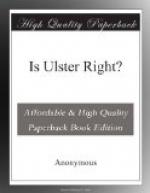Two other instances of this period must be briefly referred to. It has already been shown how the Irish Parliament endowed Maynooth as a College for Roman Catholic students both lay and theological; and how Trinity College, Dublin, opened its doors to all students, without distinction of creed. But the Roman Catholic Church turned Maynooth into a seminary for theological students only; and the bishops forbade young laymen to go to Trinity. In 1845 Sir Robert Peel attempted to supply the want by founding the Queen’s University, with Colleges at Belfast, Cork and Galway, where mixed education should be given in secular subjects, and separate instruction in those appertaining to religion; but that again was denounced as a “satanic scheme for the ruin of faith in the rising generation”; and the crusade against the university was so successful that in 1879 it was destroyed and another—the Royal University—put in its place. This in its turn was abolished in 1909; the College at Belfast was raised to the status of a University, and a new University ominously called the “National University” was founded into which the existing Colleges at Cork and Galway were absorbed, with a new and richly endowed College in Dublin at the head. It may seem strange that the Radical Government who are pledged to destroy all religious education in England should found and endow a Denominational University in Ireland. But the matter could be arranged by a little judicious management and prevarication; it was represented in Parliament that the new University was to be strictly unsectarian; during the debate, Sir P. Magnus, the member for the London University, said that he had no reason to believe that there was any intention on the part of the Chief Secretary to set up denominational Universities in Ireland; he accepted his word that they were to be entirely undenominational. Then, when the Act was passed, the Roman Catholic Archbishop of Dublin was appointed Chancellor of the National University, with a number of Jesuits as Professors, and Cardinal Logue stated as follows:—




